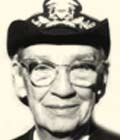
Hopper, Grace Murray (1906-1992)
Grace Hopper was mathematician, who developed the first programming language compiler and participated in working groups that developed the historic Mark I, II, III and UNIVAC I computers. She reached the rank of Rear Admiral in the US Navy.
Grace Brewster Murray was born on 9 December 1906 in New York. She changed her name to Grace Murray Hopper in 1930 when she married Vincent Foster Hopper, an English professor at New York University.
Her father, Walter Murray, was an insurance agent and her mother, Mary Van Horne, was a mathematics lover, an interest that her daughter Grace inherited.
I n 1924, she entered Vassar College and studied for a bachelor’s degree in mathematics and physics, which she earned in 1928. She then entered Yale University to pursue her studies in mathematics. She received her PhD in mathematics in 1934. Until 1943, she taught mathematics at Vassar College. Grace Hopper was a woman ahead of her time, as it was extremely unusual for a woman to attain such a level of higher education.
Shen the United States joined the Second World War, she tried to join the army, but she was rejected as being too old (34 years) and because the military authorities decided that she would better serve her country working as a mathematics professor. In 1943, however, she was admitted into WAVES (Women Accepted for Volunteer Emergency Service), and was appointed lieutenant a year later. Her first destination was Harvard University’s Cruft Laboratory, where she started work on developing computer programs for the Mark I under the leadership of Howard Aiken.
As the story goes, during her participation on the Mark II development, the system that they were debugging failed. Grace discovered that the failure had been caused by a moth stuck to a relay. She stuck the moth in her journal, and wrote “first actual bug found”. As a result she is attributed with the popularization of the terms of “bug and debug” to describe errors and error correction. The moth remains in her journal are now on display at the “Naval Surface Weapons Center”.
After the war, in 1946, she was relieved from her obligations with the Navy, but she continued as a reservist and accepted a research position in the Harvard Computation Lab, thanks to which she was able to continue working on the Mark II and then Mark III.
In 1949, she joined the Eckert-Mauchly Computer Corporation, where she worked with John Eckert and John Mauchly, parents of ENIAC, on the implementation of a new product, called UNIVAC I. She was involved in compiler development and is credited with having developed the first compiler for a programming language, known as A. The first version was A-0, and the later versions resulted in the commercial Arith-MATIC, MATH-MATIC and FLOW-MATIC compilers. FLOW-MATIC was a compiler for English-language data processing for developing management applications. At the time, the idea of being able to write programs in an English-like language instead of machine code or languages close to machine or assembly language was a major breakthrough.
In 1950, Remington Rand Corporation acquired the Eckert-Mauchly Computer Corporation and changed its name to UNIVAC Division of Remington Rand. Hopper joined the new company and continued her work on compiler development. There she was involved in the COBOL (Common Business Oriented Language) language specifications. COBOL was released in 1959. The COBOL language was defined by the CODASYL (Committee on Data Systems Languages), which extended the FLOW-MATIC language with some ideas from COMTRAN, a language developed by IBM. It also promoted the standardization of international compilers, software validation methods and compatibility between systems.
In 1955, Remington Rand Corporation merged with Sperry Corporation. Hopper continued to work at the new company until her retirement in 1971. She was an extremely active person, combining her work at the company with lecturing at computer- related events. Her lectures were known for being entertaining and irreverent, dotted with anecdotes from the war. She also worked as a guest lecturer at several universities and as a consultant and lecturer for the US Naval Reserve.
In 1966, she retired from the Naval Reserve with the rank of Commander. The following year she was recalled to join a mission that was to last about six months. When the six months were up, her orders were changed and her services were required indefinitely, and she was exempt from compulsory retirement at the age of 62 years. She was to remain there for almost 20 years until her retirement in 1986 at the age of 80.
Her work has been recognized by the US scientific and international community. She received numerous honorary degrees, awards and honours in her lifetime
In 1969, for example, she was elected “Man of the Year” by the Data Processing Management Association. In 1970, the ACM instituted the Grace Murray Hopper Award in her honour. In 1973, she was appointed Member of the National Academy of Engineering. She was appointed to the rank of Rear Admiral of the Navy in 1985. In 1986, she received the Distinguished Service Medal, the top distinction of the Defense Department. In 1991, she received the National Medal of Technology, the highest honour for technological innovation in the United States.
After her retirement, she worked as a consultant for the Digital Equipment Corporation until her death on 1 January 1992 at the age of 85 years.
